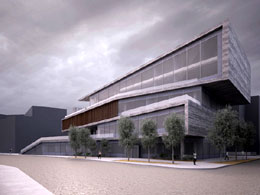STUDENTS PROJECTS
PROJECTS2013

30 April, 2014
New Townhall in Larisa
The thesis proposes the creation of the new Cityhall of Larisa city.
Students : Arvaniti Xaroula, Mavromatidi Asimina
Supervisor : Tasis Papaioannou, Eirini Klampatsea
School of Architectural Engineering of the National Technical University of Athens
Presentation date : 17/07/2013

The thesis proposes the creation of the new Cityhall of Larisa city. The idea coincides to the intention of the municipal autority to create a building that will house the municipal services in existing private land, with panoramic view to Peneus river. Starting point of our synthetic options was initially the strong presence of the river which affected the architectural composition and also the need to create a new attraction, which will invite the citizens to be informed and participate in the democratic processes of the city. Using the pattern of folding ribbon and its rotation in the third dimension, has been formed a building with a strong interaction with its environment. The unfolding as well as the twist of the ribbon have the goal to make a clear separation of the sectors of City Hall. Additionally, the turn of floors continues the city lines, keeping in this way the continuity of the urban fabric. The need to integrate the building into the urban fabric has been a key factor in the design of the free space on the rear of the site in which we created one square at a lower level.
The need to integrate the building into the urban fabric and the general city life has been a key factor in the design of the free space in the rear of the site, where it was created a public passage and a run-down square. The gesture was aimed as a bid of this public building to enter the city network flows.
The general location of the building was planned by having as an additional parameter the view towards the river, for this reason, but also for the non - disintegration of the ribbon the faces remained with transparent facades.
The organization of the spaces is driven, both by the functionality and by the hierarchy. Each floor receives one or more sections, designed open planned, without many indoors, so as to facilitate the communication and movement. In addition, the general location of services was planned by having the need of accessibility as important criterion. For this reason the services that are more accessible by public remained at lower levels. Also in places like the first basement that have more public character, it has been formed a multipurpose room and a cafeteria.
Specifically, in the ground someone meet the financial and administrative services in which there is the need for economic and other types of transactions through tellers with citizens, together with their ancillary offices. On the first floor there are the urban planning administration and the data room. Then in the next level the technical services are developed.
Finally, in the next two levels, is designed the elective section of the city hall, with hall of city council, the mayor and deputy mayors offices and the office of General Secretary. One level higher, are the consultants and the press office. The location of the hall of city council was designed that way so that it has two-storey height and symbolically completes the building.
Main parameter of the organization of the interior is an open traffic lane in the center of gravity of each floor that connects the external links with the vertical.
Finally, the vertical communication is achieved via a central staircase in the center of gravity of the composition in order to serve the connections between floors. The high transparency of the bulk, due to the northern orientation and only the turning points were treated with vertical blinds. The same logic prevails in resolving the remaining sides.
The new City Hall building, is trying to crystallize a clear dialectical relationship between state and citizen, between the public building and the city that seems to been lost, building on the syzygy "functionality - expression values".

















